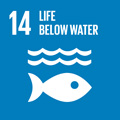- Docente: Albamaria Parmeggiani
- Credits: 3
- SSD: VET/02
- Language: Italian
- Teaching Mode: In-person learning (entirely or partially)
- Campus: Cesena
- Corso: First cycle degree programme (L) in Aquaculture and Fish Production Hygiene (cod. 8834)
-
from Feb 18, 2026 to Apr 29, 2026
Learning outcomes
At the end of the course the student will know the main functional mechanism of the organism; knowledge will be acquired on cell function, nervous system, circulatory, respiratory, digestive, muscular, excretory, and reproductive systems.
The student will be able to understand and describe the functional network relative to different apparatuses and their evolution and adaptation to aquatic life.
Course contents
The Integrated Course (IC) aims to provide students with a comprehensive overview of the anatomical, physiological, and biological characteristics of large marine vertebrates, with a focus on cetaceans. This knowledge is integrated with aspects of animal health in the wild and confined environments, to provide students with the knowledge necessary for a proper approach to large marine vertebrates, both in terms of their conservation and the zoonotic implications for public health.
By the end of the physiology course, students will understand the main mechanisms underlying the functioning of cetaceans; knowledge will cover both cellular functions and the functioning of the circulatory, digestive, respiratory, musculoskeletal, excretory, and reproductive systems. Students will acquire the ability to understand and describe the functional relationships between the various systems and how they have evolved to adapt to aquatic life.
The following topics will be covered:
- Physiology and mechanisms of cellular function: a brief review of the main functional characteristics of eukaryotic cells will be provided to provide a foundation for subsequent lessons; 1 hour
- Energy metabolism: characteristics of energy metabolism with a particular focus on metabolic adaptations to aquatic life; thermoregulation; 4 hours
- Physiology of the cardiovascular system: functions of the system and specific features related to adaptation to aquatic life and diving; 4 hours
- Physiology of the respiratory system: functions of the system and specific features related to aquatic life and diving; 4 hours
- Physiology of the excretory system: main functions of the excretory organs, urine formation, adaptation to marine salinity; 2 hours
- Physiology of the endocrine system. Hormones: secretion and function. 1 hour
- Physiology of reproduction: physiology of the male reproductive system; physiology of the female reproductive system. Neuroendocrine control of reproduction; mating and pregnancy 2 hours
- Physiology of the digestive system: food supply; main digestive functions and nutrient assimilation 3 hours
During the discussion of the various systems, reference will be made to the existing knowledge of teleost and chondrostean physiology.
Readings/Bibliography
Students who do NOT attend classes are advised not to use only the teaching material provided by the teacher for exam preparation; this material must be integrated with the recommended texts or with the notes taken during the lesson as the only images and diagrams are not sufficient for exam preparation!
- THE PHYSIOLOGY OF DOLPHINS, 2023,Edited by:Andreas Fahlman and Sascha K. Hooker
- Physiology of Domestic Animals. Sjaastadt-Sand-Hove. Scandinavian Veterinary Press second edition (2010).
- Fisiologia degli animali marini. Alessandro Poli, Elena Fabbri. EdiSES s.r.l, Napoli 2018
- Marine mammal physiology: Requisites for Ocean Living Edited by Michael A. Castellini, Jo-Ann Mellish; CRC Press 2016
- Further readings: scientific literature
Teaching methods
Lecture with interaction between teacher and students with supervised activity of review and self-evaluation; practical activity.
Assessment methods
The assessment of learning for the Integrated Course "Large Marine Vertebrates" consists of four parts.
The Cetacean Physiology section consists of an oral exam designed to assess the student's acquisition of the required knowledge.
The exam will consist of an oral interview designed to assess the student's ability to connect the various topics covered during the course and their knowledge of these topics. The exam is considered passed if the student demonstrates a grasp of the basics and specifics of cetacean physiology.
Students with learning disabilities (LD) or temporary or permanent disabilities: please contact the relevant University office promptly (https://site.unibo.it/studenti-con-disabilita-e-dsa/it/per-studenti ). The instructor will be responsible for suggesting any adjustments to the students concerned. These adjustments must be submitted 15 days in advance for approval by the instructor, who will evaluate their suitability, including in relation to the course's learning objectives.
The Large Marine Vertebrates exam is considered passed only if all required tests are passed. The final grade is the average of the scores obtained in the various sections of the exam, expressed out of 30. A minimum final grade of 18/30 is required.
Failures do not result in a grade being awarded, but merely a judgment (withdrawn or rejected) recorded on the electronic transcript compiled on AlmaEsami. Therefore, they do not affect the student's academic career.
The assessments of the individual tests and the final exam grade will be published on the recording instructor's virtual platform (https://virtuale.unibo.it/) within 5 working days of the exam date.
Students may decline a grade at least once by notifying the recording instructor via email within 5 working days.
The recording instructor for this course is Professor Zaccaroni.
Students can register for exam sessions through AlmaEsami (http://almaesami.unibo.it/). Exam sessions are offered within the timeframes listed in the academic calendar. Additional exam sessions are reserved for students who have not completed their exams.
Teaching tools
Power point slides; laboratory; teaching videos
Links to further information
http://www.acquacoltura.unibo.it/
Office hours
See the website of Albamaria Parmeggiani
SDGs




This teaching activity contributes to the achievement of the Sustainable Development Goals of the UN 2030 Agenda.
